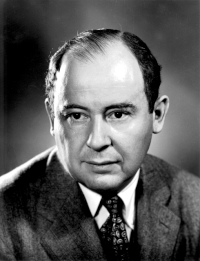John von Neumann
Ìrísí
John von Neumann (Pípè: /vɒn ˈnɔɪmən/) (December 28, 1903 – February 8, 1957) was a Hungarian American mathematician who made major contributions to a vast range of fields,[1] including set theory, functional analysis, quantum mechanics, ergodic theory, continuous geometry, economics and game theory, computer science, numerical analysis, hydrodynamics (of explosions), and statistics, as well as many other mathematical fields. He is generally regarded as one of the greatest mathematicians in modern history.[2]

|
Àyọkà yìí tàbí apá rẹ̀ únfẹ́ àtúnṣe sí. Ẹ le fẹ̀ jù báyìí lọ tàbí kí ẹ ṣàtúnṣe rẹ̀ lọ́nà tí yíò mu kúnrẹ́rẹ́. Ẹ ran Wikipedia lọ́wọ́ láti fẹ̀ẹ́ jù báyìí lọ. |
Itokasi
- ↑ Ed Regis (1992-11-08). "Johnny Jiggles the Planet". The New York Times. Retrieved 2008-02-04.
- ↑ Impagliazzo, p. vii


